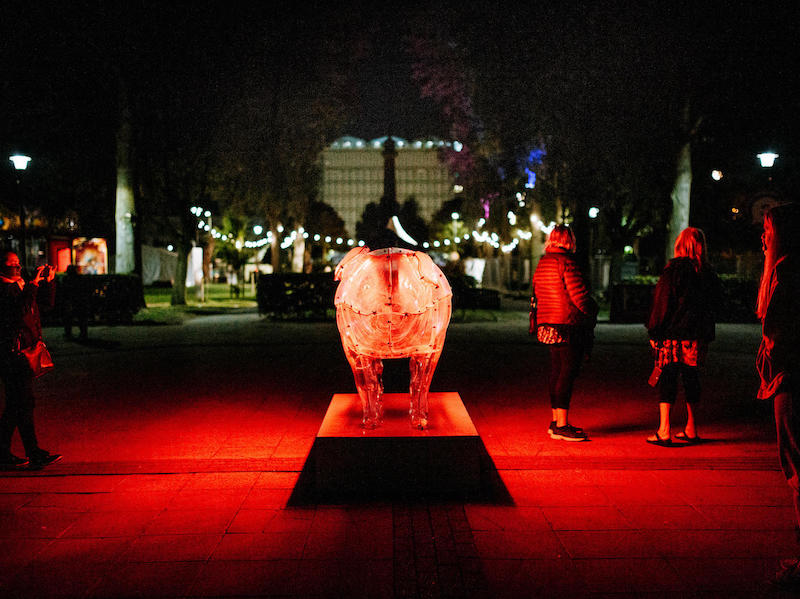
©Tom Arran - ©Tom Arran
Seth Honnor, the artistic director of Kaleider (United Kingdom) followed his PIG around Europe. PIG is an original IN SITU Pilot project focusing on the concept of collective choice and responsability. Taste a bite of its 2018 tour and read its diary.
Norfolk & Norwich Festival (United Kingdom)
Norwich. Friday 11th May. We’ve sold Pig as a concept. IN SITU has invested in its production. We’ve designed it and fabricated it. It’s about 2.2m long and 1.7m high. The sun is shining and we’ve placed it in a public space for the first time. The LED bar inside scrolls:
“This is a community fund, you can contribute to it if you like, and when you’ve agreed how to spend it you can open me and spend it.”
We sit about 50m away and watch. It’s our first experience of “Pig watching”, which over the next months will become a very particular sport.
A group of 3 girls in front of us are looking at it. They’ve read the sign. “I’m going to be the first person to put money into it.” She runs over and drops a coin into its empty belly. One of us says “It works”. But as Nadia Aguir (général manager of IN SITU) will later observe: "Pig reveals itself and the city it is in as it goes."
So, yes, people will put money in it – I never doubted this – and to that extent it works, but what is it that we have made?
The BBC point a camera at me with the Pig behind me. I’m uncomfortable. It will be the last time I am filmed or photographed as the proud farmer standing beside his pig. It isn’t mine – it’s the public’s.
The first opening in Norwich brings a tangible relief to the Norfolk and Norwich Festival team members. It’s been opened by someone who has seen it on TV and she’s come down with some 7 year olds from her football team. The manager has run off and taken the money for their new kit with him. The paper photograph the entire team of 7 year olds in front of the pig. I like it, you couldn’t make it up, but I feel myself waiting for the next story as soon as I’m told this one. It will come, and then another, and another.
Security staff from the adjacent public building take it upon themselves to prevent “some Italian kids” from opening it because they’re “not from here”.
A man who the police later describe as “from the street community” attempts to open it. Someone calls the police. The police arrive and question the people watching and the man. As they question him he closes the Pig without taking any money. The police agree he has done nothing wrong. He leaves.
A self identifying elderly woman calls the Norfolk and Norwich Festival office to ask if she can open it for her group. They fold the responsibility back to her. She’s worried that they won’t look as good as the kids in the paper. The following day an elderly lady and two young children open Pig and take “half” the money to give to an elderly group and a pre-school. No one approaches them or challenges them.
Kids seem to love putting money in. Maybe they don’t yet care for its value. “Mummy, mummy can I put some money in?” To which the reply comes: “I’ll see if I can find some brown ones.”
Getting into my car late on a Friday. I’m tired. I check my emails on my phone. Mark Denbigh has written. It simply says: “We had another opening this morning. A Big Issue seller – wasn’t sure he would have sold enough Big Issue’s this morning and needed bus fare to visit his partner who was at the hospital. He took £12 to cover his bus fare and two coffees and left the rest. He was helped to open it by member of Forum security and then did all the bolts back up.”
A tear wells up in my eye. Pig “works”.
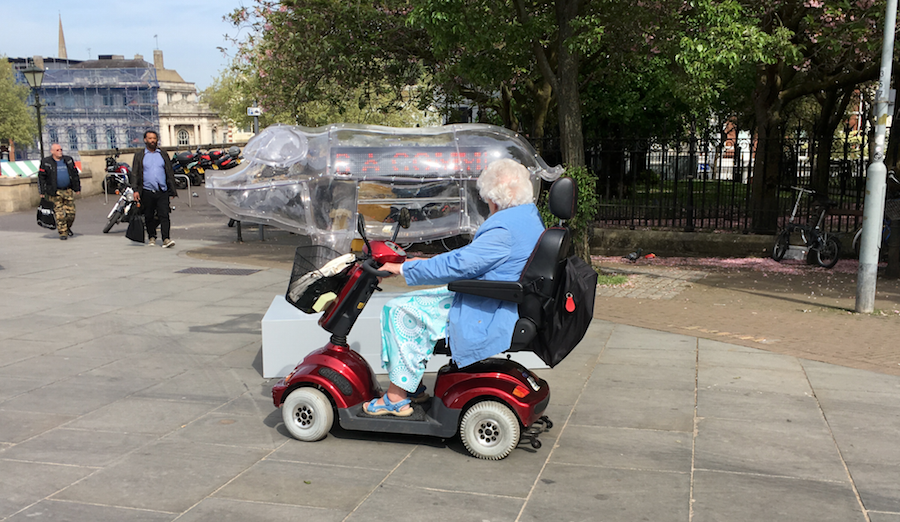
Oerol Festival (The Netherlands)
On Terschelling Island we decide to move it around every other day or so. The project becomes about the pilgrimage to find Pig. In that way Pig becomes somewhat of a celebrity. People tell me that they found it but “not that much happened”. I agree – “people walk up to it, read the sign, look quizzical and then either put money in or not”. The temporal nature of Pig isn’t like the other work they’re experiencing – it’s a slippery pig.
“Utterly fascinating reactions from passers by. More smart work from the creators of The Money and one which puts its trust in people and thinks the best not the worst of them.”Lyn Gardner, Writer for The Stage and Novelist
At our communal breakfast on the boat where I’m staying artists come and go. We talk about each other’s work, but the conversation dwells on Pig far longer than I’m comfortable. We propose a “swear jar”: €1 for saying “pig”… but what would we do with the money!?
Pig gets stolen. A group of eight lift it up to take it towards a pub where they think it will get more money. They only get 200m before Island Security find them and ask them to take it back.
Some staff at the festival are worried that it isn’t “working” because they can’t see it. In response we put it right into the middle of a busy festival site. It gets used as a beer mat. We never do this again. From now on we trust that it is doing its job even when we can’t see it doing its job.
It’s the last day. A man and a small boy walk up to the Pig as we’re installing it on the beach. “I told my friends I was coming to Oerol and they asked me if I would see the Pig”. News of Pig has made it to the mainland. Apparently you don’t need to be beside Pig for it to do its thing, you just need to hear about it.
On Terschelling it wasn’t the money that created a new community, but the Pig itself.
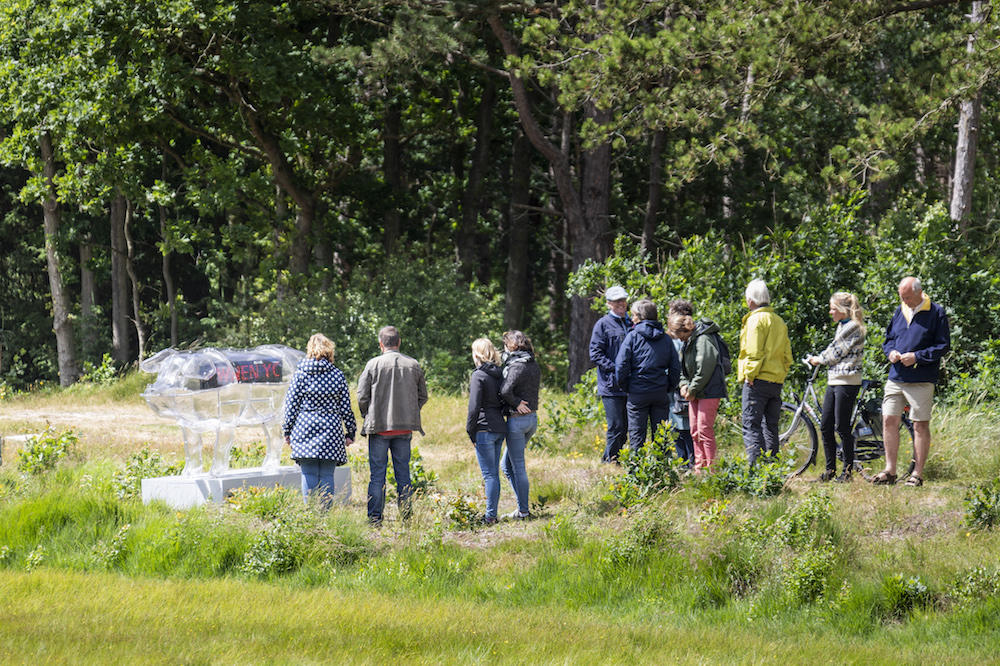 The PIG in Oerol ©Moon Saris
The PIG in Oerol ©Moon Saris
Østfold Kulturutvikling (Norway)
August, Moss, a small city in Norway. No festival, no announcement. Both the city and regional newspapers get interested and run articles. The story quickly becomes about where the mysterious Pig has arrived from. One paper does some impressive investigative journalism, and after seeing a British coin in a trotter traces Pig to Kaleider and then to the promoter James Moore. Both papers run two more large articles. I arrive in the last days of two weeks. I come down to breakfast to Pig filling the front page of the newspaper.
No one has opened Pig. The Norwegians are beside themselves with wanting someone to be a tall poppy and open it. But their welfare state is strong, things are ok. I’m told it is deeply engrained that no one should think that they are better than another and so maybe no one will open it. People tell us they have overheard two people on the bus arguing about the pig and what fellesskapet was and wasn’t, the word James chose to use in place of community as the Norwegian language has no direct translation. Another tells us it was being talked about at bingo. The Mayor comes to talk to us.
In the last hour of two weeks (we didn’t publicise the end date), late at night, a young man opens it. A friend on a bike circles a long way off. Some children come to watch. James films him and asks him what he’s going to use the money for: A community organic farm – he wants to save the world. He drops each bolt carelessly onto the ground, spinning the butterfly nuts off and letting them fall too. He leaves one bolt in, so that as he takes the top off it twists, but doesn’t break. He scoops up two weeks worth of donations. He is scooping for what seems like forever, placing it in his opened coat on the ground. He ties up his coat and holds his hoard aloft. He leaves the lid in its sorry state, hanging half off. The papers continue to run stories.
 The PIG in Moss ©Fedrik Borgund
The PIG in Moss ©Fedrik Borgund
Freedom Festival (United Kingdom)
We pack up Pig and send it to Hull for Freedom Festival. It’s September. I arrive in central Hull early in the morning from a whistle-stop tour of another show in Taipei and Netherlands. The late summer sun is warm. Little did I know, particularly after Norway, that the following 3 days were to be some of the most emotionally expensive of my artistic career.
Pig arrives before breakfast on a telehandler into the historic heart of the city, Beverly Gate. We turn it on. It does its thing. People put money in. Some open it and take money out. And so on. The police arrive. The superintendent gets in touch and asks “if there’s a spike in deaths tonight due to increased drug taking how will you reconcile that?” A duality of “this is not the responsibility of this artwork”, and “I definitely don’t want anyone to die” rises up in me. We talk with the police, who calm down, they ask us to move Pig to a festival site, and I witness some impressive liberal policing with full understanding of the artwork and full cooperation with the festival to make it brilliant and keep people safe.
Over the next few days thousands of pounds is placed in Pig and taken out in at least 12 openings. It is busy. A world away from Moss. I can’t leave the site for long, pulled to observation by moral duty.
I’m told by a BBC reporter that 1 in 3 people in Hull grow up in poverty. 1 in 3, in the fifth richest country in the world. Add to this a street drug problem that is not in any way under control and this conversation, inevitably, rises right to the top of the agenda, in the press, amongst the festival going public, with the police, on social media. A perfect storm of hot summer sun, money, and sometimes as many as 200 people around Pig at any one time.
People putting money in on one side whilst others take it out the other. A cute transparent pig asking a city to face itself.
There are too many Hull stories to do any justice here. But like everywhere Pig has been, each story sheds new light on the stories that have gone before.
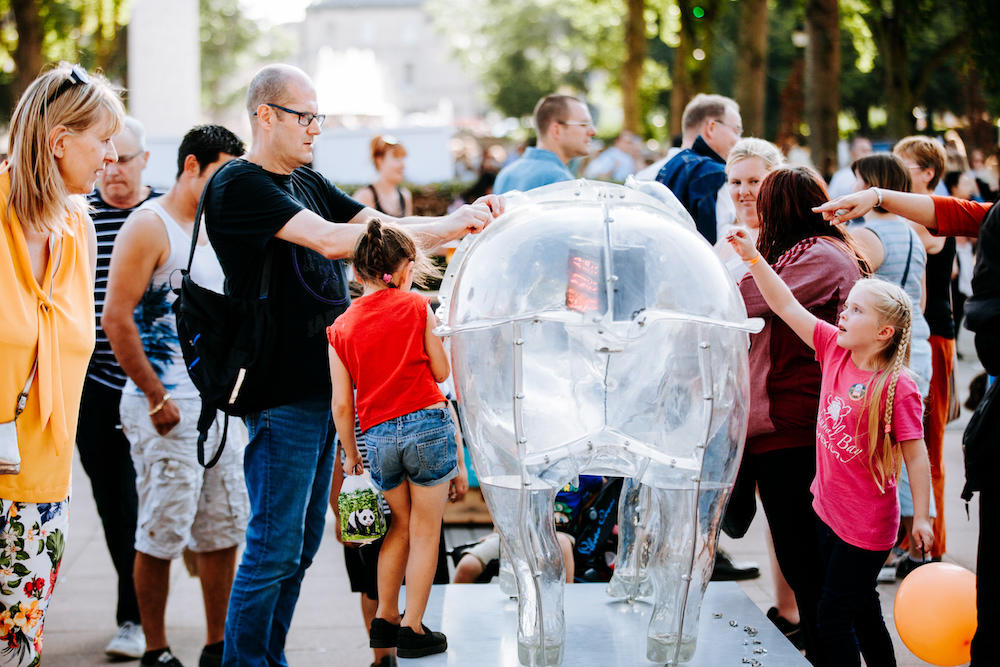 The PIG at the Freedom festival ©Tom Arran
The PIG at the Freedom festival ©Tom Arran
Travellings (France)
After Hull, Marseille, with £400 in its belly from the people of Hull. When we said we were taking Pig to Marseille people drew breath in through their teeth as if to say “you’re insane”. But we weren’t, and Marseille was, in short, what we have come to expect from Pig: It attracts the curious and the rebellious, to engage in the humour, and the play. It asks a question about the commons and what makes up our communities, about how we will make decisions about our planet when we are 12 billion, about how we come to agreement and with who. And it attracts people in uniform.
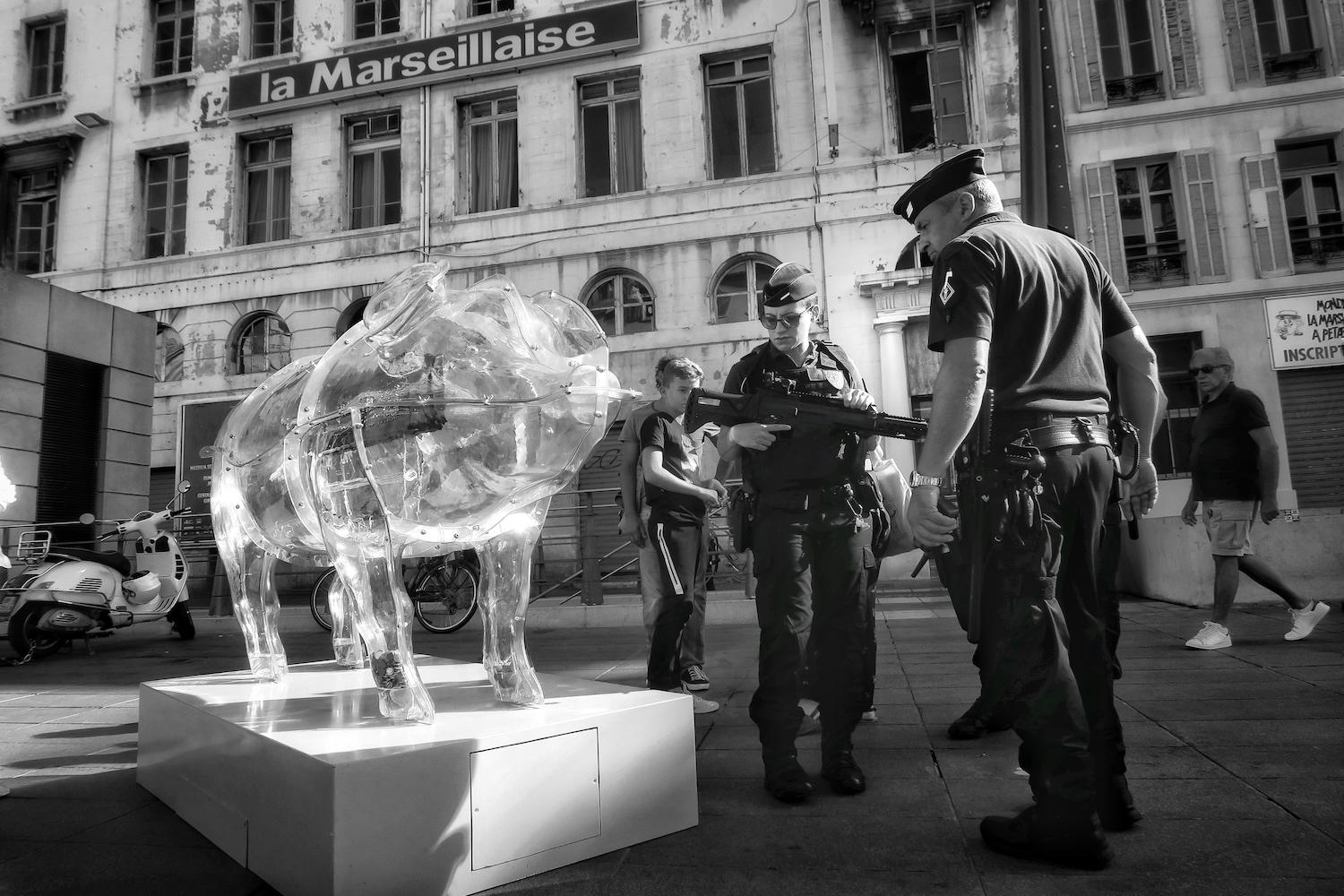 The PIG in Marseille ©Didier Verdureau
The PIG in Marseille ©Didier Verdureau
Pigzine
One of the concerns from commissioners investing public money in this project was how we captured the stories. Of course, many, many stories are out of reach by the nature of the work, but we developed Pigzine to try and capture some of this European story. Throughout the tour Pig has been accompanied by Pigzine reporters: young reporters recruited locally to work alongside our own young Editor in Chief Natasha Batorijs. The reporters collect stories from the public about openings, ask passers-by probing and disarming questions about Pig and gather those stories together on pigzine for everyone to read. You can read them too, I will let Pigzine speak for itself: pigzine.com

